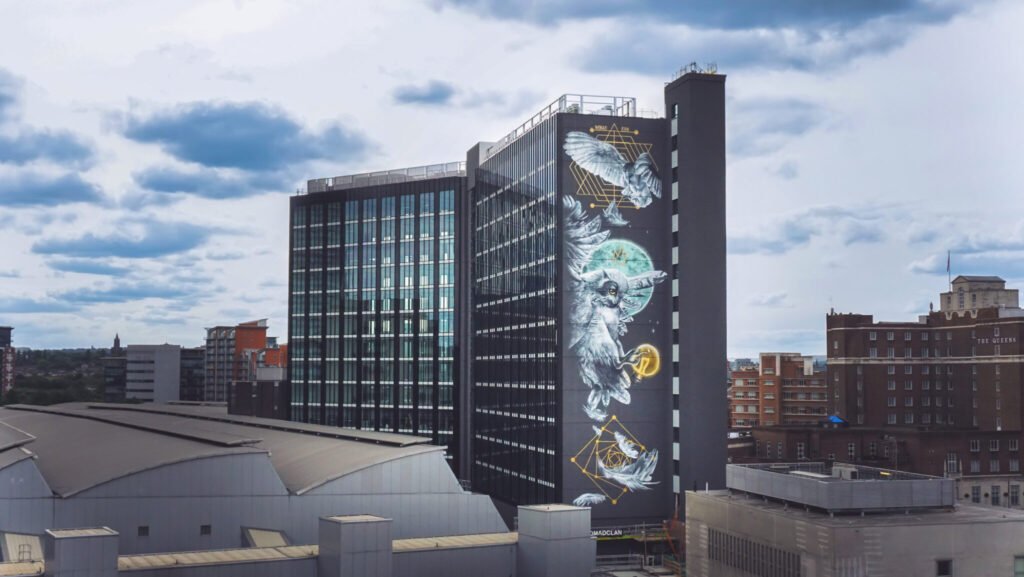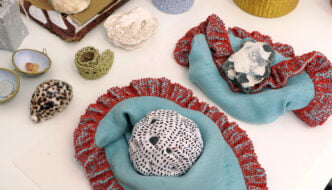 The first thing you see as you come into Leeds train station is a gigantic piece of public art. The piece, by the art duet Nomad Clan called ‘Athena Rising’, depicts an owl against a backdrop of a full moon, emblazoned across the newly refurbished platform building. It is the tallest piece of street art in the UK.
The first thing you see as you come into Leeds train station is a gigantic piece of public art. The piece, by the art duet Nomad Clan called ‘Athena Rising’, depicts an owl against a backdrop of a full moon, emblazoned across the newly refurbished platform building. It is the tallest piece of street art in the UK.
From the mural on the side of Kirkgate Market that says “Welcome to Leeds”, to the classical themed mural above the fish shop by the Corn Exchange, the centre of Leeds is dotted with public art. Look further out and the theme continues – outside the Compton Centre is the statue ‘Harehills Hare’, and on Mabgate there is the Mabgate Mural.
But with Leeds City Council announcing that it needs to save significant amounts of money due to costs associated with COVID-19, it seems all the more relevant to ask: how were these pieces of public art funded, and is the future of public art in Leeds and other northern cities under threat?
To find the answer to some of these questions, I spoke to Karen Watson, co-founder and artistic director of East Street Arts, one of the most prominent arts organisations in Leeds.
Karen begins by reaffirming the importance of public art in how a city defines itself: “As our cities start to increasingly resemble each other, with the same department stores, the same chains of shops, when you look up and you can see something that’s totally unique, that reflects something about the city around you. That transforms the space around you into somewhere special, somewhere with its own unique identity.”
In 2016 the organisation launched ‘A City Less Grey’, a project that supports artists and the partnerships between artists, Leeds City Council and Leeds Business Improvement District (LeedsBID) to create different kinds of public art, from mosaics to statues, across the city. The project comments:
“At a time when our high streets are in need of re-invention, our cities need to stand out from others – our creative industries are leading the way in developing bespoke environments. We work with artists and use their ideas, passions and skills to open up the city to expose talent and engage participants and visitors.
“‘A City Less Grey’ builds on the rich history of Leeds and its important role within the country’s industrial development from manufacturing, printing, IT and engineering. The project has firmly put Leeds on the map as a city committed to developing its public art voice.”
Some of the pieces, such the ‘Harehills Hare’, were funded by Leeds City Council; others by private businesses. Historically, this has always been the case in Leeds. The classical themed mosaic above the chip shop beside the Corn Exchange called ‘Copernica’ was commissioned by the real estate developer Speciality Shops as part of the redevelopment of the Corn Exchange in 1989.
‘Athena Rising’, perhaps one of most striking examples of modern public art in Leeds, is funded by the LeedsBID. According to its website, LeedsBID “is focused on delivering an ambitious business plan to transform Leeds city centre. Leading on innovative projects and providing key investment, it aims to make Leeds city centre a cleaner, safer and more welcoming place.”
Businesses in the bid area, which roughly encompasses the city centre, have a real-table value of £60,000 or above and make an annual contribution of 1.25%. Together, they provide an investment of £2.4m per year into the city centre.
In other northern cities the local authority plays an even more important role in public art. Beam is an arts charity based in Wakefield.
“From our perspective, Wakefield Council are proactive in promoting public art opportunities within new developments and we have historically worked with them on a number of commissions”.
One of the largest recent pieces of public art in Wakefield are in the City Fields development near the city centre. This collection is going to be made of different sculptures, ornate walkways and lighting and will be funded by a combination of developer money, as well as funding from the national Lottery and various local charities and trusts.
I asked them if there were any other funders who can step in to fill the gap if funding was reduced due to the lack of development in a recession. They responded:
“We often work on projects where we have put together funding packages from a range of sources – for example the Featherstone War Horse, by CodSteaks – which was partly funded by Featherstone Town Council, an Arts Council grant and a grant from WREN landfill and tax credits were used to fund the physical building of the work.”
The looming threat of a serious recession casts doubt over the willingness of business to continue investing in projects like the LeedsBID and the lack of new developments would definitely reduce the section 106 paid local authorities.
Karen Watson, from East Street Arts comments: “I am concerned that in a recession art is one of the first things to go, understandably. But I feel that when we lose out on art we are loosing one of things that make life worth living, that public art helps beak down the idea that art is something shut away over there and not part of the community.”
The Leeds BID seems keen to support public art. Karen Butler, LeedsBID’s Head of Place Management & Delivery, comments: “Public art plays such an essential part in place shaping, celebrating creativity and culture while animating the city centre.”
“LeedsBID has been able to work with business and artists to collaborate on bringing bold statement pieces to life, injecting colour into key areas and brightening up the streets, and will continue to explore opportunities to improve the look, feel and experience of being in Leeds.”
Kully Thiarai, Chief Executive and Creative Director of Leeds 2023, is equally vocal about the importance of art in the future. On their website she writes: “As we emerge slowly from lockdown it seems a good time to reflect on what we have learnt during this period of isolation, anxiety and loss. During these hard times creativity and culture have played their part in bringing people joy, solace, friendship and entertainment.
“Creative activity has been instrumental in supporting people during lockdown. However, we can deliver more than sticking plasters: we can use our landmark year of culture in 2023 to unlock opportunities for everyone across our region to live their best life.”
Filed under: Art & Photography
Tagged with: art, charity, city council, covid19, funding, hare, leeds, public, public art, sculpture, value, Wakefield



Comments